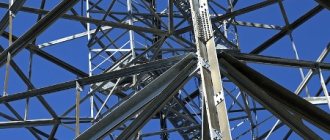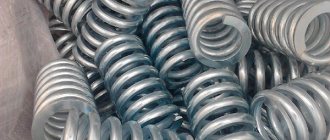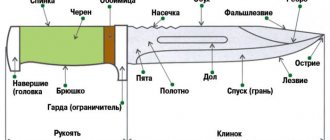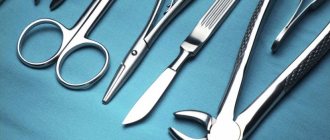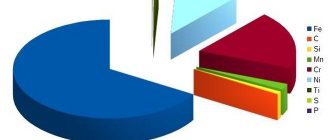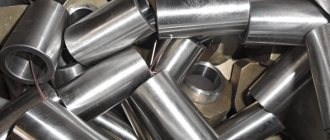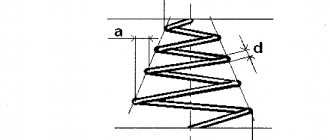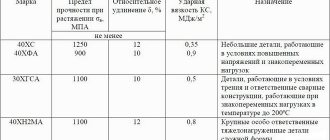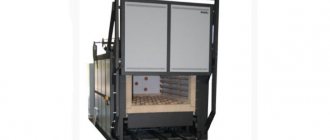Application of carbon steel
Based on the level of carbon percentage, which affects the mechanical properties of the base, it is divided into groups:
- low carbon (up to 0.25%);
- low-carbon (0.3-0.6%);
- high carbon (0.6-2%).
The substance is used to make structures for construction and mechanical engineering. Blanks based on it are used when laying pipeline networks. Structural grade 20 is especially in demand among injection molding machine manufacturers. It is suitable for creating compact devices (screws, flywheels, nails, wire) and large objects (bends, transitions).
Advantages of carbon alloys:
- good weldability;
- amenable to hot and cold processing;
- withstand elevated temperatures;
- low price.
The main disadvantage of products made from this material is their susceptibility to corrosion and rust. Metal structures that come into contact with moisture and air are especially vulnerable to these processes. In this case, the iron begins to quickly oxidize, and rusty marks appear on the surface of the product.
Classification of carbon steels by degree of deoxidation
Calm
Such alloys have the most uniform structure. For deoxidation, aluminum, ferrosilicon and ferromanganese are used, which almost completely remove the gases present in the melt. The combination of the almost complete absence of gases with a fine-grained structure due to the presence of residual aluminum ensures good quality of the metal. These grades are suitable for the manufacture of parts, products and structures for critical purposes. The main disadvantage is the high cost.
Boiling
This is the cheapest and least quality group. Due to the use of a minimal amount of additives for deoxidation, dissolved gases are present in the material, which cause heterogeneity in the structure, chemical composition, and therefore mechanical properties. Such metals have poor weldability, since due to the presence of gases there is a high probability of cracks forming at the seams.
Semi-calm
The group occupies an intermediate position in terms of cost and characteristics. Much fewer gas bubbles form in the casting compared to boiling steels. When rolling, internal defects in the bulk are eliminated. Such materials are often used as structural alloys.
Where is stainless steel used?
The material, which is not subject to corrosion damage, contains chromium in an amount of 10-11%. Its structure also includes carbon, but most steel is made of iron. To improve the strength of a corrosive alloy, alloying components (sulfur, titanium, cobalt, phosphorus, nickel) are introduced into it.
In production, the 12x18n10t grade is most often used. Components, for example, bends made on its basis, are characterized by good weldability, resistance to aggressive substances, and durability. The service life of certified stainless steel pipeline fittings is, for example, 20-40 years. At the same time, it retains its original appearance for a long time and does not require painting.
The scope of application of raw materials is wide. It includes:
- energy;
- pharmacology, medicine;
- aviation, automotive industry;
- oil and gas sector;
- food, chemical industry.
Disadvantages of raw materials: high price, difficult to machine.
Alloy steel
is a type of steel and has a large number of other elements besides iron and carbon. The main difference between alloy and unalloyed steel is that in alloy steel, the remaining elements are added to iron during smelting whereas in unalloyed steel, no elements are added during smelting.
There are two main types of alloys as substitution alloys and interstitial alloys. When molten metal is used in the production of alloys, the sizes of the atoms will determine what type will be formed. If the metal atoms that come together to be mixed have relatively equal sizes, a substitute type of alloy is formed, but if one type of metal atom is smaller than another type, an intermediate alloy is formed.
Which is better: stainless steel or carbon?
Disputes on this topic have been going on for a long time. But this formulation of the question is not entirely correct: the word “carbon” refers to the percentage of carbon in the alloy, and the definition “stainless” emphasizes the ability of the material to resist corrosion.
The fundamental (but not the only!) difference between one substance and another is rust resistance. In addition, structures made of carbon steel quickly absorb foreign odors, while stainless steel is not susceptible to this. This can be especially important when choosing household steel products (for example, when purchasing kitchen knives).
A composition with a high carbon content has better cutting properties. Its pliable structure lends itself better to sharpening, and its cutting edge will be thinner than an edge made from a non-corrosive alloy.
The areas of application of the two steels are also different. Carbon is used to produce small parts and tools that do not require the improved properties of the metal. It is in demand in areas where durable metal is needed in large quantities: for example, when laying highway networks.
Structures that work with aggressive mixtures are made on the basis of stainless steel. They are installed in the chemical, oil and gas industries. Stainless steel is preferred when creating parts with improved strength and durability (medicine, aircraft, and shipbuilding).
Classification of structural carbon steels by quality, their marking and application
Structural steels of ordinary quality
They are produced in accordance with GOST 380-2005 and supplied for sale in the form of sheets, sections and shaped products. GOST implies the release of the following brands:
- St0;
- St1ps, St1sp, St1kp;
- St2ps, St2sp, St2kp;
- St3ps, St3sp, St3kp, St3Gsp, St3Gps;
- St4ps, St4sp, St4kp;
- St5ps, St5sp, St5Gps;
- St6ps, St6sp.
Alphanumeric marking of this group of alloys:
- St – steel;
- numbers 0-6 indicate the brand number;
- the presence of the letter “G” in the designation indicates the presence of manganese in an amount of 0.8% or more;
- the last two letters characterize the degree of deoxidation, sp - calm, ps - semi-calm, kp - boiling.
What are the differences?
The iron in carbon steel quickly oxidizes when the carbon comes into contact with oxygen in the air or water. Stainless steel contains additives: chromium, molybdenum and the like. They make it more resistant to oxidation; in rare cases, it succumbs to corrosion.
These steels are not interchangeable, since their properties and purposes are different. Before choosing one over another, it is important to determine what it will be used for and then compare the differences in aesthetics, properties and cost.
Chemical composition
Carbon steel is created by combining carbon and iron. Various impurities such as sulfur, silicon, phosphorus and manganese are removed during the production process. The carbon content makes it tough and durable.
Stainless steel production follows the same steps, but chromium, nickel, nitrogen, and molybdenum are added to it. Chromium content is a key factor. It must be at least 10.5%. Chromium plays an important role in protecting the metal by creating a passive surface layer. This layer protects against rust and promotes self-healing when minor abrasions occur.
Metallurgical products
Structural carbon steel - a general term for varieties of a group of steels intended for the manufacture of blanks in the form of castings, castings, parts and assemblies for machines and mechanisms. Cast structural steels with a carbon content of up to 0.7% are widely used in mechanical engineering, machine tools for the manufacture of body parts, frames and bases, parts that transmit torques, perform linear movements, and carry tensile, bending and torsion loads. At the same time, steels with a carbon content not exceeding 0.25%, used for building structures, must have high weldability. A distinction is made between carbon steel and high-strength low-alloy steel (less than 5% alloying elements); Structural steel is also distinguished by purpose (steel for the construction of bridges, for elements of high-rise buildings, military and aviation equipment, as well as for the preparation of parts). Structural steels can be obtained by casting into various forms (for example: pulleys, gears, plates, housing parts, etc.) thereby obtaining them ready for use as load-bearing elements of machine structures and independent elements.In the manufacture of castings, GOST 977-88 , GOST 21357-87 . Allowances and tolerances according to GOST 26645-85 . Steel is a universal material. Depending on its purity, alloying and heat treatment, the properties of steel can be soft or hard, tensile, wear-resistant, corrosion-resistant and heat-resistant. Structural steels are usually divided into: carbon (unalloyed) and alloyed.
Carbon (unalloyed) steel refers to alloys and steels in which the proportion of carbon is from 0.1% to 1.5% carbon and the maximum value specified for any of the following elements does not exceed the percentage: manganese 1.65%, silicon 0.60%, copper 0.60%. As a group, carbon steels are often produced and used as castings. The production of more than 85% of steels is carbon steels, which are currently the most accessible and cheapest. Changes in carbon content have the greatest impact on the mechanical properties of steels. Mild steel (low carbon) has relatively low strength and tensile strength, and the surface hardness can be increased by carburizing. During the carburization process, metal is heated in the presence of materials containing carbon (for example, charcoal or carbon monoxide) to carburize the parent metal. Accordingly, if the carbon content is increased, this will lead to an increase in hardness, as well as an increase in the strength of the steel. Consequently, carbon steels are usually divided according to the degree of carbon content in them: low-carbon ( 15L , 20L , 25L ), medium-carbon ( 30L , 35L , 40L , 45L ) and high-carbon ( 50L , 55L ).
Purpose of steels:
Steel 25L : rolling mill beds, pistons, cylinder covers, axle boxes, roller tables and trolleys, traverses, frames and various parts used in work under pressure and extreme temperatures.
Steel 30L : levers, couplings, balancers, gear housings, brackets, bowls, support rings, bandages, beds, beams, flywheels and other parts used under various loads, as well as vibrations.
Steel 35L : gears, rods, runners, rolling mill beds, valves, balancers, rollers, rolls, diaphragms, brackets and other parts used under various loads, as well as vibrations.
Steel 40L : brake discs, frames, housings, couplings, gears, casings and other parts operating in chain drives.
Steel 45L : brake discs, couplings, frames, spindles, frame wheels, gear wheels and rims and other parts, the requirements for which are characterized by increased strength, wear resistance and operating under various loads, as well as vibrations.
Steel 55L : couplings for hoisting and transport machines, half-couplings, bushings of gear couplings, load-bearing wheels, detachable and gear rims, ramps and other parts, the requirements for which are characterized by increased hardness.
Previous articles:
- 17/10/2012 11:03 —
High Speed Steel Tool Steel High speed steel is a subset of tool steels widely used in attachments and cutting tools...">High-speed steel
Similar articles:
- 02/11/2012 16:43 —
Steel grade 20Х25Н19С2Л Heat-resistant steel 20Х25Н19С2Л Steel grade 20Х25Н19С2Л, offered by the Litshtamp production association, is…">Steel 20Х25Н19С2Л
- 16/10/2012 12:20 —
Stainless Steel In metallurgy, stainless steel, also known as Corrosion Resistant Steel, is defined as a steel alloy with a minimum of 10.5% to…">Corrosion-resistant steel
- 20/07/2012 13:32 —
Steel is an alloy of iron and other elements, the most common of which is carbon. Carbon content in steel is from 0.2% and 2.1% by weight...">Steel
- 04/24/2012 13:43 — Steel
- 09/04/2012 19:15 —
Structural alloy steels according to the degree of alloying are divided into low-alloy steels (less than 5% of alloying elements), medium alloy steels (...">Low alloy steels
Next articles:
- 09/04/2012 17:28 —
High alloy steels contain more than 10% alloying components. In their composition, they should not contain more than 0.045% phosphorus and sulfur taken together...">High alloy steels
The most common grades of medium carbon steels
- 40G – structural steel. Characterized by a high Mn content. In combination with silicon (0.37%), manganese provides a high degree of deoxidation and smooth pouring. This medium carbon steel is quenched and tempered to improve its strength characteristics.
- 50 G. It is distinguished by a combination of strength and elastic characteristics. The heat treatment methods used are hardening + tempering, less often - normalization.
- 40ХН . A grade characterized by high strength, elasticity, machinability, and deep hardenability.
- 50HF . Spring steel, in demand in the production of high-duty springs. The chromium and vanadium content increases elasticity properties.
- 60, 60G, 65, 65G, 70, 70G, 80, 85 are used after hardening + tempering, normalization + tempering, surface hardening. They are in demand for the manufacture of parts operating under conditions of friction, static pressure and vibration.
- U7, U8, U9, U10 are tool steels with low hardenability.
Steel C45E / 1.191 mechanical properties
Yield strength
Yield strength Reh, MPa
- mechanical characteristic of C45E steel, characterizing the stress at which deformations continue to increase without increasing the load. After passing the yield point, irreversible changes begin to occur in the C45E steel sample, the crystal lattice is rearranged, and significant deformations appear.
| Standard | steel grade | Nominal thickness(mm) | Yield strength Reh, MPa |
| EN 10083-2 | C45E/1.1191 | >16≤100 | 305 |
| EN 10083-2 | C45E/1.1191 | >100 ≤250 | 275 |
Tensile strength
Tensile strength Rm, MPa
— mechanical stress R at which destruction of C45E steel occurs.
| Standard | steel grade | Nominal thickness(mm) | Tensile strength Rm, MPa |
| EN 10083-2 | C45E/1.1191 | 16 < a ≤ 100 | 580 |
| EN 10083-2 | C45E/1.1191 | 100 < a ≤ 250 | 560 |
Relative extension
| Standard | steel grade | Nominal thickness(mm) | Relative elongation A, % |
| EN 10083-2 | C45E/1.1191 | 16 < a ≤ 100 | 16 |
| EN 10083-2 | C45E/1.1191 | 100 < a ≤ 250 | 16 |
Calculation relative to elongation A, %: Lo = 5.65 √So
Comparison of carbon steel with stainless steel
Ability to absorb odors
Carbon steel itself has a pleasant smell (especially when clean and freshly sharpened), but it quickly absorbs foreign odors. If we plan wood with a carbon knife, this is even great, but for cutting food it is not very good: the “aroma” of onions or smoked fish will take a long time to wash off the tool. There are no such problems with stainless steel; it itself is also odorless. For kitchen knives this is a definite plus.
Sharpening
With the same amount of carbon, blades made of corrosion-resistant steels will be more difficult to sharpen due to increased wear resistance. Therefore, editing blades made of high-carbon, corrosion-resistant steel will require a special tool: a fine-grained water stone or a ceramic finishing rod. Carbon steel blades, on the other hand, can be sharpened even with ordinary chef's rub. The sharpness achieved in this case, according to practitioners, far exceeds the sharpness of edges made from corrosion-resistant analogues, although it is somewhat inferior to them in durability and wear resistance. Simply put, a carbon blade is easier to sharpen, edits easier, and cuts better than a stainless steel counterpart, but is inferior in corrosion resistance and longevity of sharpness.
Easy to care for
Both steels definitely require regular cleaning, straightening, sharpening and proper storage. Moreover, if you really do this constantly, then care in both cases will be simple; but carbon steel is still more sensitive to “inattention”. Stop caring for high-carbon and stainless steel at the same time, and the former will most likely “revenge” with the appearance of rust.
Cutting properties
Here high-carbon steel definitely wins. Due to its more pliable structure, it is more sensitive to sharpening, and a cutting edge made of high-carbon steel can be much thinner than one made of stainless steel. And this determines, as they say, “sharpness.”
The aesthetic side of the issue
- Stainless steel does not require additional protection against corrosion, so it is often simply polished. But high-carbon steel ends up looking much more diverse, since a variety of processing methods are used for blades made from it: their purpose is functional, but they also “give” the steel individuality. For example, bluing gives the blade an elegant black color, blackwash coating gives an unusual gray-green tint and thousands of micro-scratches, powder coating gives a matte texture. In principle, the same can be done with stainless steel, but this is not usually practiced.
- Sooner or later, a dark, uniform coating forms on the carbon, which naturally protects the blade from further oxidation; Whether we like this unauthorized coloring of the blade or not is an individual question. Nothing like this happens with stainless steel.
